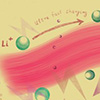| Oct 31, 2022 |
|
(Nanowerk News) As the electric vehicle (EV) industry is advancing, so are the efforts in the research and development of superior lithium (Li)-ion batteries to power these vehicles. Exploring and expanding rapid charge-discharge technology and extended battery life are critical challenges in their development. A few factors, such as the diffusion of Li ions, characteristics of the electrode-electrolyte interface, and electrode porosity, can help overcome these issues achieve extreme fast charging and ultralong life.
|
|
In recent years, two-dimensional (2D) nanomaterials, which are thin sheet-like structures with a thickness of a few nanometers, have emerged as potential anode materials for Li-ion batteries. These nanosheets possess a high aspect ratio and high density of active sites, which enables fast charging and superior cycling performance.
|
|
In particular, 2D nanomaterials based on transition-metal diborides (or TMDs) have piqued the interest of researchers. TMDs have been found to have a high rate and long cycling stability for Li ion storage, owing to their honeycomb planes of boron and multivalent transition-metal atoms.
|
|
Recently, a group of scientists led by Prof. Noriyoshi Matsumi from the Japan Advanced Institute of Science and Technology (JAIST) and Prof. Kabeer Jasuja from the Indian Institite of Technology (IIT) Gandhinagar set out to further explore the potential of TMDs for energy storage. The team conducted the first experimental study on the storage potential of titanium diboride (TiB2)-based hierarchical nanosheets (THNS) as an anode material for Li-ion batteries. The team comprised Rajashekar Badam, former Senior Lecturer at JAIST; Akash Varma, former M.S. Course Student at JAIST; Koichi Higashimine, Technical Specialist at JAIST and Asha Liza James, Ph.D. Student at IIT Gandhinagar.
|
|
Their study was published in ACS Applied Nano Materials (“Titanium Diboride-Based Hierarchical Nanosheets as Anode Material for Li-Ion Batteries”).
|
 |
| Researchers demonstrated the efficiency of titanium diboride-based nanosheets (THNS) as anode material in Li-ion batteries. These batteries sustain high current densities which enable ultra-fast charging and high retention capacity delivering superior cycling performance. (Image: Kabeer Jasuja)
|
|
The THNS were developed by oxidizing TiB2 powder with hydrogen peroxide, followed by centrifuging and freeze-drying the solution. “What makes our work stand out is the scalability of the method developed for synthesizing these TiB2 nanosheets. For any nanomaterial to translate into a tangible technology, scalability is the limiting factor. Our synthesis method only requires stirring and no sophisticated equipment. This is on account of the dissolution and recrystallization behavior exhibited by TiB2, a serendipitous discovery that makes this work a promising bridge from lab to the field,” explains Prof. Kabeer.
|
|
Thereafter, the team constructed an anodic Li-ion half-cell using the THNS as active anode material. The team studied the charge-storage characteristics of the THNS-based anodes.
|
|
The team found that the THNS-based anode showed a high discharge capacity of 380 mAh/g with a current density of just 0.025 A/g. Furthermore, they saw that a discharge capacity of 174 mAh/g could be obtained for a high current density of 1 A/g, with a charge time of 10 min and a capacity retention of 89.7% after 1,000 cycles. Additionally, the THNS-based Li-ion anode could sustain very high current rates, in the order of 15 to 20 A/g facilitating ultrafast charging in about 9 to 14 seconds. Under the high current rate, with a capacity retention greater than 80% was observed after 10,000 cycles.
|
|
The results of this study indicate the suitability of the 2D TiB2 nanosheets as a candidate for fast-charging and long-life Li-ion batteries. They also highlight the advantage of nano-scaling bulk materials, like TiB2, to attain promising properties, including pseudocapacitive charge storage, excellent high-rate capability, and superior cyclability.
|
|
Explaining the potential long-term effects of their research, Prof. Matsumi says, “Such quick-charging technology can accelerate the diffusion of EVs and significantly decrease waiting times for charging various mobile electronic devices. We hope our findings can stimulate more research in this field, which can eventually lead to the convenience of EV users, lesser air pollution in cities, and less stressful mobile life in order to enhance the productivity of our society.”
|


